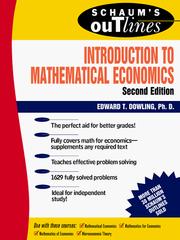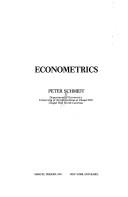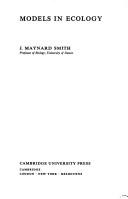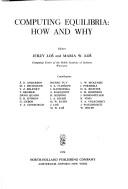| Listing 1 - 10 of 69 | << page >> |
Sort by
|
Book
ISBN: 9781408264331 1408264331 9781292071312 Year: 2012 Publisher: Boston (Mass.): Pearson,
Abstract | Keywords | Export | Availability | Bookmark
 Loading...
Loading...Choose an application
- Reference Manager
- EndNote
- RefWorks (Direct export to RefWorks)
Book
ISBN: 3540105581 3642483186 9783540105589 Year: 1981 Volume: 186 Publisher: Berlin: Springer,
Abstract | Keywords | Export | Availability | Bookmark
 Loading...
Loading...Choose an application
- Reference Manager
- EndNote
- RefWorks (Direct export to RefWorks)
This mono graph is intended for an advanced undergraduate or graduate course as weIl as for the researchers who want a compilation of developments in this rapidly growing field of operations research. This is a sequel to our previous work entitled "Multiple Objective Decision Making--Methods and Applications: A State-of-the-Art Survey," (No. 164 of the Lecture Notes). The literature on methods and applications of Multiple Attribute Decision Making (MADM) has been reviewed and classified systematically. This study provides readers with a capsule look into the existing methods, their char acteristics, and applicability to analysis of MADM problems. The basic MADM concepts are defined and a standard notation is introduced in Part 11. Also introduced are foundations such as models for MADM, trans formation of attributes, fuzzy decision rules, and methods for assessing weight. A system of classifying seventeen major MADM methods is presented. These methods have been proposed by researchers in diversified disciplines; half of them are classical ones, but the other half have appeared recently. The basic concept, the computational procedure, and the characteristics of each of these methods are presented concisely in Part 111. The computational procedure of each method is illustrated by solving a simple numerical example. Part IV of the survey deals with the applications of these MADM methods.

ISBN: 0070176744 9780070176744 Year: 1992 Publisher: New York (N.Y.) : McGraw-Hill,
Abstract | Keywords | Export | Availability | Bookmark
 Loading...
Loading...Choose an application
- Reference Manager
- EndNote
- RefWorks (Direct export to RefWorks)
Mathematics --- Economics --- Economics, Mathematical --- Economics, Mathematical. --- Mathematics. --- 519.86 --- Math --- Science --- Mathematical economics --- Econometrics --- Theory of economic-mathematical models --- Methodology --- 519.86 Theory of economic-mathematical models
Dissertation
ISBN: 9789086496716 Year: 2013 Publisher: Leuven Katholieke Universiteit Leuven
Abstract | Keywords | Export | Availability | Bookmark
 Loading...
Loading...Choose an application
- Reference Manager
- EndNote
- RefWorks (Direct export to RefWorks)

ISBN: 0824763645 9780824763640 Year: 1976 Volume: 18 Publisher: New York (N.Y.) : Dekker,
Abstract | Keywords | Export | Availability | Bookmark
 Loading...
Loading...Choose an application
- Reference Manager
- EndNote
- RefWorks (Direct export to RefWorks)
Econometrics --- Econométrie --- 519.86 --- Econometric models --- Mathematical models --- Theory of economic-mathematical models --- Econometrics. --- 519.86 Theory of economic-mathematical models --- Econométrie --- Economics, Mathematical --- Statistics

ISBN: 0521294401 Year: 1978 Publisher: Cambridge ; New York, NY : Cambridge University Press,
Abstract | Keywords | Export | Availability | Bookmark
 Loading...
Loading...Choose an application
- Reference Manager
- EndNote
- RefWorks (Direct export to RefWorks)
Book
ISBN: 0824780396 Year: 1989 Volume: vol 128 Publisher: New York Basel Dekker
Abstract | Keywords | Export | Availability | Bookmark
 Loading...
Loading...Choose an application
- Reference Manager
- EndNote
- RefWorks (Direct export to RefWorks)
519.86 --- Operations research --- -Operational analysis --- Operational research --- Industrial engineering --- Management science --- Research --- System theory --- Theory of economic-mathematical models --- Mathematics --- -Theory of economic-mathematical models --- 519.86 Theory of economic-mathematical models --- -519.86 Theory of economic-mathematical models --- Operational analysis --- Recherche opérationnelle --- Mathematics. --- Mathématiques. --- Programming (Mathematics) --- Programmation (mathématiques) --- Programmation (mathématiques) --- Recherche opérationnelle --- Mathématiques.
Book
ISBN: 9519174206 9519174214 9789519174204 9789519174211 Year: 1982 Publisher: Helsinki: Insurance Publishing Co.,
Abstract | Keywords | Export | Availability | Bookmark
 Loading...
Loading...Choose an application
- Reference Manager
- EndNote
- RefWorks (Direct export to RefWorks)
Insurance --- Mathematical models --- Reserves --- 519.86 --- -Insurance --- -Assurance (Insurance) --- Coverage, Insurance --- Indemnity insurance --- Insurance coverage --- Insurance industry --- Insurance protection --- Mutual insurance --- Underwriting --- Finance --- Theory of economic-mathematical models --- -Mathematical models --- -Theory of economic-mathematical models --- 519.86 Theory of economic-mathematical models --- -519.86 Theory of economic-mathematical models --- Assurance (Insurance) --- Insurance - Finland - Mathematical models --- Insurance - Reserves - Mathematical models
Book
ISBN: 3540091114 0387091114 3642455115 9783540091110 Year: 1979 Volume: 164 Publisher: Berlin: Springer,
Abstract | Keywords | Export | Availability | Bookmark
 Loading...
Loading...Choose an application
- Reference Manager
- EndNote
- RefWorks (Direct export to RefWorks)
Decision making is the process of selecting a possible course of action from all the available alternatives. In almost all such problems the multiplicity of criteria for judging the alternatives is pervasive. That is, for many such problems, the decision maker (OM) wants to attain more than one objective or goal in selecting the course of action while satisfying the constraints dictated by environment, processes, and resources. Another characteristic of these problems is that the objectives are apparently non commensurable. Mathematically, these problems can be represented as: (1. 1 ) subject to: gi(~) ~ 0, ,', . . . ,. ! where ~ is an n dimensional decision variable vector. The problem consists of n decision variables, m constraints and k objectives. Any or all of the functions may be nonlinear. In literature this problem is often referred to as a vector maximum problem (VMP). Traditionally there are two approaches for solving the VMP. One of them is to optimize one of the objectives while appending the other objectives to a constraint set so that the optimal solution would satisfy these objectives at least up to a predetermined level. The problem is given as: Max f. ~) 1 (1. 2) subject to: where at is any acceptable predetermined level for objective t. The other approach is to optimize a super-objective function created by multiplying each 2 objective function with a suitable weight and then by adding them together.
Mathematical statistics --- Decision Making --- Mathematical models --- Management --- Business & Economics --- Management Theory --- 519.86 --- Theory of economic-mathematical models --- 519.86 Theory of economic-mathematical models --- Decision making --- Prise de décision --- Modèles mathématiques --- Decision Making - Mathematical models

ISBN: 0720428378 9780720428377 Year: 1976 Publisher: Amsterdam: North-Holland,
Abstract | Keywords | Export | Availability | Bookmark
 Loading...
Loading...Choose an application
- Reference Manager
- EndNote
- RefWorks (Direct export to RefWorks)
Economics --- Equilibrium (Economics) --- Economics, Mathematical --- Mathematical models --- 519.86 --- Theory of economic-mathematical models --- 519.86 Theory of economic-mathematical models --- Equilibrium (Economics) - Congresses --- Economics - Mathematical models - Congresses --- Economics, Mathematical - Congresses
| Listing 1 - 10 of 69 | << page >> |
Sort by
|

 Search
Search Feedback
Feedback About UniCat
About UniCat  Help
Help News
News